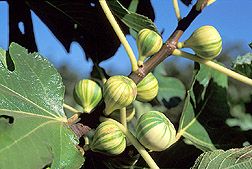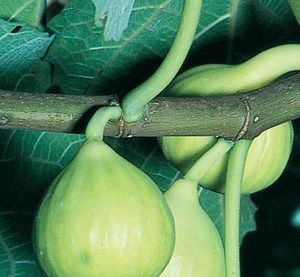

 | Green Ischia Fig Tree 4" x 9" grower's pot Hailing from the Bay of Naples along with so many other choice edibles, the Green Ischia fig tree offers an accommodating nature along with decadent flavor. The light to dark green skinned fruit is filled when ripe with carmine raspberry flesh as soft as custard. Holds the flavor when dried. Breba crop is sparse but main crop is plentiful. Ripens late. Small tree suitable for container growing. Will ripen even in cool summer areas. Trees are pruned to about 3' tall, 1/2" trunk, dormant as of January 2023. OUT OF STOCK. | |
 | Sequoia Fig Tree 1 gal Like California Chrome, another California bred powerhouse who was unappreciated until his Derby win, the Sequoia fig surpasses its peers in performance. The tree is compact yet vigorous when grown from cuttings (rather than the tissue culture specimens used in early trials). Leaves are deeply lobed, even more so than Negronne's. And those plentiful twice a year fruit! The Calimyrna heritage is evident on first bite of the celadon skinned fig, with amber flesh you'll swear is made from marzipan. Fruit will ripen in both coastal and interior regions. As of March 2019, trees are about 3' tall, 1/2" caliper. Grown in 1 gal pots. Propagation of this patented variety is prohibited. OUT OF STOCK. | |
 | Janice Seedless Kadota Fig Grower's Pot Janice Seedless Kadota is a fairly new cultivar that's gaining admirers every time someone bites into these nearly seedless white figs. The fruit provides an immersion into the world of honey and true fig flavor without the cloying sensation of too much sugar. The tree is adaptable, thriving along the coast as well as inland. Amenable to hard pruning, which will provide bumper crops on new wood in the fall. Excellent for pot culture. Grown in 4" x 9" grower pots. Pruned to about 3' tall, trunk about 1/2" caliper, dormant as of January 2023. OUT OF STOCK. | |
 | Panachee 'Tiger' Fig Tree Grower's Pot Panachee is also known as the Tiger fig and you'll know why when you see these striped and stippled green and yellow beauties. Crimson flesh turns to jam as the fruit ripens and this brings out the strawberry/orange flavors. Needs a long, warm growing season. Ripens late, so not suitable for cold climates. No breba crop, but a prolific late crop. Great for containers. Pruned to 3' tall, 1/2" caliper trunk, going dormant as of September 2021. Grown in 4" x 9" pots. OUT OF STOCK. | |
 | Panachee Tiger Fig Tree 1 gal Same cultivar as the Panachee in the grower's pot, this version is grown in a 1 gal container. As of May 2020, plants are about 2.5' tall, 1/2" caliper trunk. OUT OF STOCK. | |
 | Lattarulla Fig Tree 4" x 9" grower's pot Also known as the Italian Honey fig, Lattarulla is the most reliable fig for short-season, cool summer areas such as the Northwest and Northern California. The Lattarulla fig tree produces lots of figs twice a year, even in containers. The green skin brings a welcome tartness to the sweet taste of the honey-colored flesh. Grown in 4" X 9" grow pots, pruned to about 3' tall, 1/2" caliper trunk as of March 2023. | |
 | White Genoa Fig Tree Grower's Pot The White Genoa fig tree is an heirloom fig justly famous for the delicious juicy pale rose pulp of its green skinned fruit. Not much of a breba crop, but excellent main crop of turban shaped figs. Best suited for areas with mild summers, does not hold up in desert climates. Very late crop and can even ripen after first frosts. Upright grower that responds well to annual pruning. Grown in 4" x 9" grower pots. Thick trunk, about 1/2" caliper. These trees have been pruned to about 3' as of January 2023. OUT OF STOCK. | |
 | Negronne Fig Tree Grower's Pot Also known as Violette de Bordeaux, the irresistible fruit of the Negronne fig tree has the sweetest, darkest red flesh of any fig. Spread a ripe Negronne fig on a piece of toast and you'll swear you're eating raspberry jam. Bears at an early age. Negronne leaves are a deep, rich green, narrower and more deeply lobed than other varieties. The tree is a natural dwarf, adapts easily to container culture, and can give you two crops of succulent figs a year. Adaptable to coastal and inland areas. Who could ask for anything more? As of September 2023, trees are about 3' tall with 3/8" caliper, going dormant. Grown in 4" x 9" pots. | |
 | Peter's Honey Fig Tree 1 gal The best-tasting fig to be introduced into the U.S. in years, Peter's Honey fig tree produces a soft celadon green fruit on the outside. When you bite into the dark amber flesh, you'll understand why this variety has become so popular since its arrival from Sicily. Needs a warm location for proper ripening. A stone wall is a perfect backdrop. Second crop is early, so Peter's Honey fig is suitable for locations with early frost. Well-developed as of January 2023, about 2.5' tall, 1/2" caliper trunk, dormant. Grown in 1 gal containers. OUT OF STOCK. | |
 | Peter's Honey Fig Tree Grower's Pot Same admirable qualities as the Peter's Honey fig in the 1 gal containers, these trees are grown in 4" x 9" grower's pots for longer roots. About 3' tall, 3/8" caliper, going dormant as of September 2023. | |
 | Black Spanish Fig Tree 1 gal Black Spanish fig is a popular small fig tree along the West Coast. Its bruised purple fruit shows up reliably from August through October. Whether grown in a container or in the ground, you'll harvest big fruit perfect for the table or for drying. Grown in 1 gal pots, plants as of October 2022 are going dormant, pruned to about 3' tall, 1/2" caliper trunk. OUT OF STOCK. | |
 | Black Jack Fig Tree grower's pot Another dwarf variety suitable for container growing, Black Jack fig trees bear heavily twice in the season and are easy to maintain at 6' tall in containers. Fruit, which starts green and changes to purple right before it's ripe, is large and elongated, with juicy and sweet strawberry flesh. Grown in 4" x 9" tree pots, these Black Jack trees are about 3' tall and beginning to leaf out as of April 2024. | |
